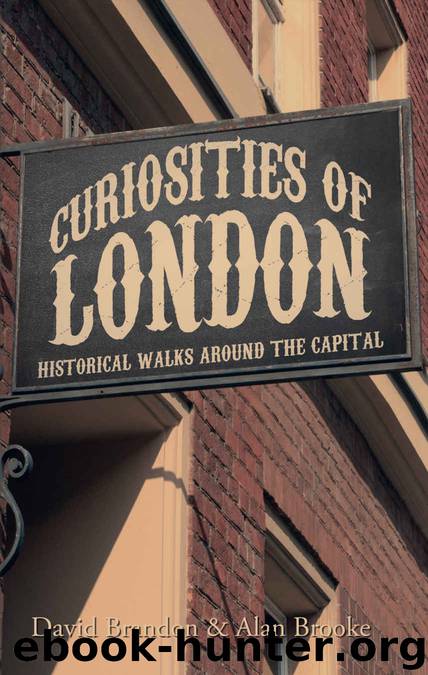Curiosities of London: Historical Walks Around the Capital by Brandon David & Brooke Alan

Author:Brandon, David & Brooke, Alan
Language: eng
Format: epub
Publisher: Amberley Publishing
Published: 2015-06-13T16:00:00+00:00
Plaque at the entrance to Pickering Place.
Duke Street crosses Jermyn Street at right angles. Turn north into Duke Street. Where it meets Piccadilly is the world-famous emporium of Fortnum & Mason. On the façade is a clock, put there in 1964, where, as the hour strikes, models of the original eighteenth century partners of the firm emerge from two little boxes and bow to each other. When the chimes have sounded, they bow again and retreat into their boxes. Turn right along Piccadilly and right again into Eagle Place where on the left there is an interesting piece of trompe-l’oeil at street level on a building which appears to be empty and awaiting redevelopment.
Duke of York Street runs south from Jermyn to St James’s Square. This was intended to be the centrepiece of a building development financed by Henry Jermyn, Earl of St Albans, on a greenfield site just north of St James’s Palace. Work started in the 1660s and the idea was that the residential properties in the area would be for wealthy and prestigious occupants, many of whom would be involved with courtly duties around St James’s or in the Palace of Westminster. The scheme was a successful one and for half a century St James’s Square was the focal point of the most desirable residential district in London. In the 1680s no fewer than six dukes had residences in the square. Prestige is still attached to the houses round the square but most if not all are now used for commercial purposes. An equestrian statue of William III stands in the gardens in the square (not open to the public at weekends). A foreigner and a dour man little loved by his subjects, especially the Jacobites (those who were loyal to the Stuart pretenders to the throne), William died from injuries sustained when he fell from his horse when it stumbled on a molehill. This fall was greeted with acclaim by the Jacobites who, every year on the anniversary of William’s death, used to drink a toast to the mole responsible for the accident. It was described as ‘the gentleman in black velvet’.
In the square, opposite No. 5, stands a memorial to WPC Fletcher. In 1984, during a political demonstration, the young policewoman was shot and killed by gunfire coming from this house, then used as the Libyan People’s Bureau. This was followed by a siege lasting ten days, but those inside the house claimed diplomatic immunity and were allowed to leave the UK. On the same side of the square is a low stone block. Was it a mounting block?
Download
This site does not store any files on its server. We only index and link to content provided by other sites. Please contact the content providers to delete copyright contents if any and email us, we'll remove relevant links or contents immediately.
Shoot Sexy by Ryan Armbrust(17633)
Portrait Mastery in Black & White: Learn the Signature Style of a Legendary Photographer by Tim Kelly(16931)
Adobe Camera Raw For Digital Photographers Only by Rob Sheppard(16880)
Photographically Speaking: A Deeper Look at Creating Stronger Images (Eva Spring's Library) by David duChemin(16597)
Bombshells: Glamour Girls of a Lifetime by Sullivan Steve(13949)
Art Nude Photography Explained: How to Photograph and Understand Great Art Nude Images by Simon Walden(12950)
Perfect Rhythm by Jae(5302)
Pillow Thoughts by Courtney Peppernell(4188)
The Book of Joy by Dalai Lama(3879)
Good by S. Walden(3467)
The Pixar Touch by David A. Price(3343)
A Dictionary of Sociology by Unknown(2994)
Fantastic Beasts: The Crimes of Grindelwald by J. K. Rowling(2970)
Humans of New York by Brandon Stanton(2810)
Stacked Decks by The Rotenberg Collection(2790)
Read This If You Want to Take Great Photographs by Carroll Henry(2653)
On Photography by Susan Sontag(2560)
Insomniac City by Bill Hayes(2475)
Photographic Guide to the Birds of Indonesia by Strange Morten;(2475)
